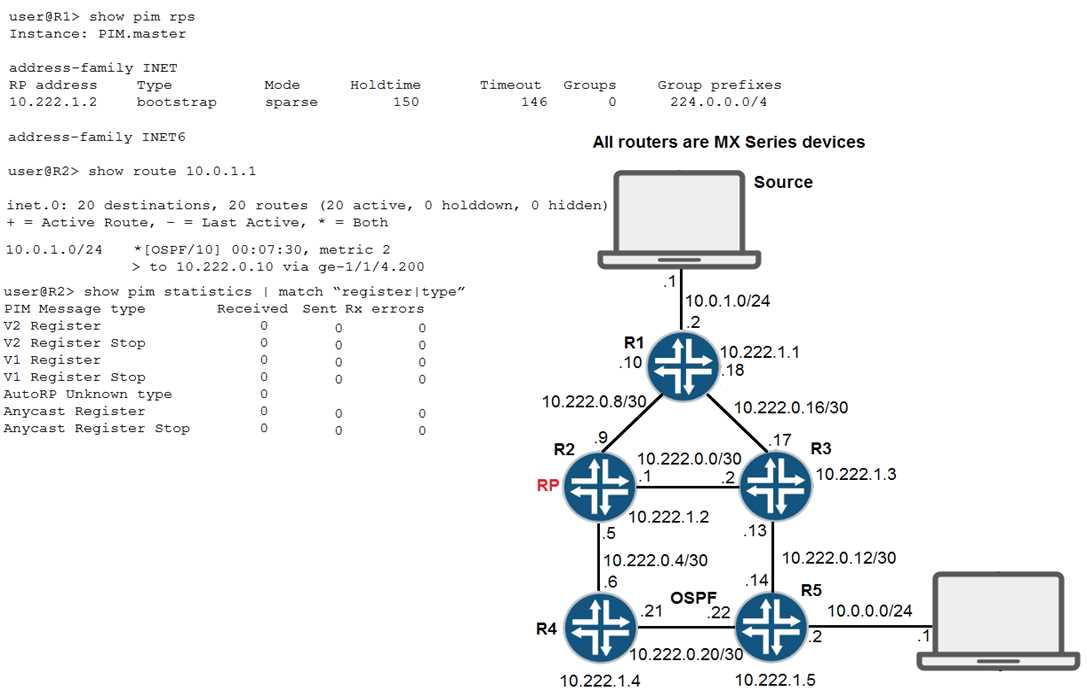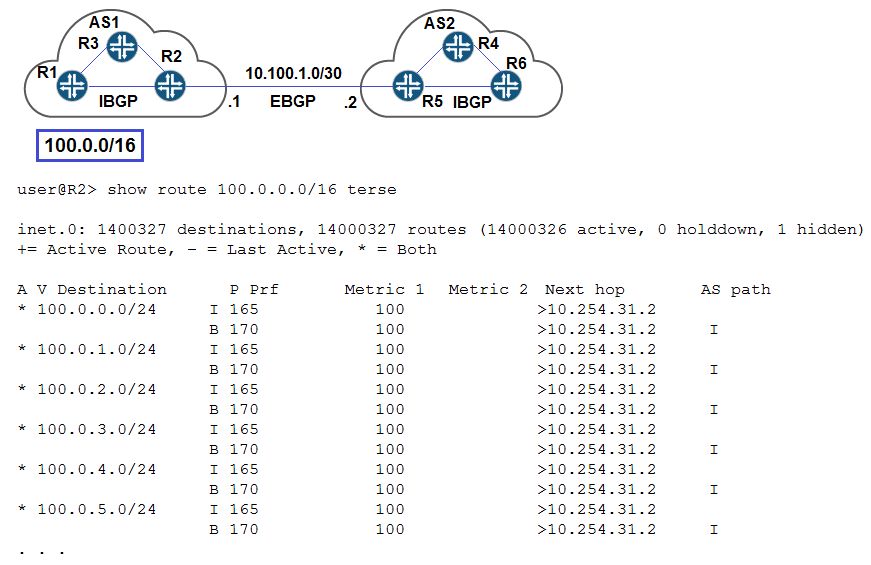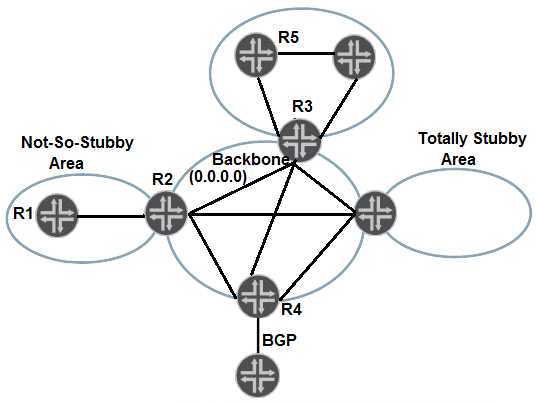Juniper jn0-648 practice test
Enterprise Routing and Switching, Professional Exam
Last exam update: Jul 20 ,2024
Question 1
Your company has expanded into office space across the street. The new office space has a single
Ethernet
connection connected to an unmanaged switch. You must sort traffic based on the IP address into
different
VLANs once the traffic arrives on your EX Series switches.
D18912E1457D5D1DDCBD40AB3BF70D5D
Which mechanism would you use to accomplish this task?
- A. MVRP
- B. filter-based VLANs
- C. Q-in-Q tunneling
- D. dynamic VLANs
Answer:
B
Explanation:
https://next-hop-self.com/juniper-filter-based-vlan-assignment.html
https://www.juniper.net/documentation/us/en/software/junos/routing-policy/topics/example/firewall-filter-ex-series-configuring.html
Question 2
Click the Exhibit button.
Referring to the exhibit, the source is currently sending multicast traffic using group 224.1.1.1, which
is being received by R1. R2 is not receiving PIM register messages.
What would be the cause of this problem?
- A. Tunnel services have not been enabled on R1.
- B. All routers have not been configured with the same Auto-RP discovery group.
- C. R5 has not received an IGMP report of 224.1.1.1.
- D. A(*,G) tree has not been built yet.
Answer:
A
Explanation:
The multicast traffic being sent by the source must be encapsulated into a PIM register packet. If the
tunneling services under the chassis stanza is not configured, a PE (PIM Encapsulation interface) will
not be present in the multicast first hop router. Anyway long story short, tunneling services must be
turned on or else you will not get PIM register messages sent to the RP.
https://kb.juniper.net/InfoCenter/index?page=content&id=KB13329
Question 3
Click the Exhibit button.
Referring to the exhibit, you must advertise the 100.0.0.0/16 routes from AS1 to AS2, but R2 is not
advertising any BGP routes to R5.
Why is this happening in this scenario?
- A. The IBGP routes will not be advertised because you must use a policy to advertise IBGP routes.
- B. The IBGP routes are not active and EBGP will advertise only active routes.
- C. The IBGP routes will not be advertised because the AS path shows as incomplete.
- D. The IBGP routes are not active because the next hop is not reachable.
Answer:
B
Explanation:
https://www.juniper.net/documentation/en_US/junos/topics/concept/policy-routing-policies-actions-defaults.html
Default BGP Export Policy:
Readvertise all active BGP routes to all BGP speakers, while following protocol-specific rules that
prohibit one IBGP speaker from readvertising routes learned from another IBGP speaker, unless it is
functioning as a route reflector.
ed@vMX-PE1# show protocols bgp group eBGP | display set
set protocols bgp group eBGP type external
set protocols bgp group eBGP family inet unicast rib-group inet0-to-test
set protocols bgp group eBGP peer-as 3
set protocols bgp group eBGP neighbor 10.0.13.3
[edit]
ed@vMX-PE1#
Question 4
You have an IPv4 multicast network configured as PIM-SM.
What must be done before replacing your static RP with auto-RP?
- A. Enable sparse-dense mode on each of the routers in the network.
- B. Configure auto-RP domains on each router in the network.
- C. Configure each router in the network as a candidate BSR.
- D. Enable each router in the network to forward multicast packets.
Answer:
A
Explanation:
https://www.juniper.net/documentation/en_US/junos/topics/task/configuration/mcast-pim-auto-rp.html
"Because PIM dense mode is necessary to enable auto-RP to work, which in turns enables PIM
sparse mode to work, you must configure PIM sparse-dense mode in the PIM domains that use auto-
RP."
Question 5
You have multiple BGP routes to the same prefix with equal local-preference values and AS-path
lengths.
In this scenario, which route will be preferred in the route selection process?
- A. The route with the least preferred origin value.
- B. The route with the lowest MED value.
- C. The route with the most preferred origin value.
- D. The route with the highest MED value.
Answer:
C
Explanation:
https://www.juniper.net/documentation/en_US/junos/topics/reference/general/routing-protocols-address-representation.html
Question 6
Click the Exhibit button.
There is a functioning OSPFv3 neighborship between Router-1 and Router-2 over the ge-0/0/1 link.
However, the 172.100.100.0/24 and 172.101.101.100/24 routes are not being shared through
OSPFv3.
Referring to the configuration shown in the exhibit, which two actions must you take to solve the
problem? (Choose two.)
- A. Add interface ge-0/0/1 under the IPv4 unicast realm for both routers.
- B. Add the IPv6 family protocol under ge-0/0/2 for both routers.
- C. Add the lo0 interface under OSPFv3 for both routers.
- D. Add interface ge-0/0/2 under OSPFv3 for both routers.
Answer:
AB
Question 7
Click the Exhibit button.
Referring to the exhibit, how is R5 able to learn the networks that exist within the NSSA?
- A. R5 learns those networks from Type 3 LSAs advertised by R2.
- B. R5 learns those networks from Type 3 LSAs advertised by R3.
- C. R5 does not learn those networks and uses a default route advertised by R3 instead.
- D. R5 does not learn those networks but uses a default route advertised by R2 instead.
Answer:
B
Question 8
You have configured class mode power management on an EX4300 to provide PoE power to
telephone and
security camera equipment. You want to ensure that security camera power takes priority over
telephone
power.
Which two actions would solve this problem? (Choose two.)
- A. Connect the security cameras to the lowest port numbers on the switch.
- B. Set the power priority to high on ports connected to security cameras.
- C. Set the maximum power settings on ports connected to security cameras.
- D. Set the power priority to low on ports connected to security cameras.
Answer:
AB
Explanation:
https://www.juniper.net/documentation//en_US/junos/topics/concept/poe-overview.html#jd0e1522
Thus you must set interfaces that connect to critical powered devices, such as security cameras and
emergency phones, to high priority. Among PoE interfaces that have the same assigned priority,
power priority is determined by the port number, with lower-numbered ports having higher priority.
Question 9
You are using 802.1X in your access network consisting of EX Series switches. You recently had a
failure with
your RADIUS server which resulted in authenticating client devices being denied access to the
network. You
want to change this behavior so that authenticating clients are directed to a remediation VLAN.
Which RADIUS server failback setting satisfies this requirement?
- A. permit
- B. move
- C. sustain
- D. deny
Answer:
B
Explanation:
https://www.juniper.net/documentation/en_US/junos/topics/topic-map/radius-server-configuration-ex-series-cli.html#id-configuring-radius-server-fail-fallback-cli-procedure
Permit authentication, allowing traffic to flow from the end device through the interface as if the end
device were successfully authenticated by the RADIUS server.
Deny authentication, preventing traffic from flowing from the end device through the interface. This
is the default.
Move the end device to a specified VLAN if the switch receives a RADIUS access-reject message. The
configured VLAN name overrides any attributes sent by the server. (The VLAN must already exist on
the switch.)
Sustain authenticated end devices that already have LAN access and deny unauthenticated end
devices. If the RADIUS servers time out during reauthentication, previously authenticated end
devices are reauthenticated and new users are denied LAN access.
Question 10
You have an MX960 configured as a Fusion aggregation device (AD) and two QFX5100 switches as
satellite
devices (SD). You have configured local-switching for each SD. A packet with an unknown MAC
address
is received on one of the SD extended ports.
Which statement is correct in this scenario?
- A. The packet is dropped and a reject message is sent out to the port where it was received.
- B. The packet is silently discarded and a reject message is sent to the AD.
- C. The packet is flooded out of all the ports on the SD except the one where it was received.
- D. The packet is sent to the AD to be processed and forwarded. D18912E1457D5D1DDCBD40AB3BF70D5D
Answer:
D
Explanation:
https://www.juniper.net/documentation/en_US/junos/topics/concept/fusion-local-switching.html
Question 11
You notice a mass withdrawal of routes for some of the network hosts. You determine that the link
on the ESI
interface is down.
Which route type is used in this scenario?
- A. Type 2
- B. Type 3
- C. Type 1
- D. Type 5
Answer:
C
Explanation:
https://www.juniper.net/documentation/en_US/junos/topics/concept/evpn-bgp-multihoming-overview.html#jd0e270
This is a Type 1 mandatory route, used for fast convergence and for advertising the split horizon
label. It is also known as the mass withdraw route.
Question 12
You must ensure that all management traffic sourced from your Junos devices is set with a specific
DSCP
code-point value.
Which action will accomplish this task?
- A. Apply the DSCP code-point to the [edit class-of-service host-outbound-traffic] hierarchy.
- B. Apply the DSCP code-point to the [edit class-of-service interface lo0.0] hierarchy
- C. Apply the DSCP code-point in an egress policer.
- D. Apply the DSCP code-point to a rewrite rule.
Answer:
A
Explanation:
https://www.juniper.net/documentation/en_US/junos/topics/concept/cos-host-outbound-traffic-default-classification-and-dscp-remarking.html
To change these default settings, include the forwarding-classclass-name statement and the dscp-
code-pointvalue statement at the [edit class-of-service host-outbound-traffic] hierarchy level. This
feature does not affect transit traffic or incoming traffic.
Question 13
You have configured CoS on a Junos device. A packet is classified as best effort by a behavior
aggregate
(BA) classifier, and as expedited forwarding by a multifield (MF) classifier.
Which statement is true in this scenario?
- A. The packet will be placed in a queue associated with the BA classifier.
- B. The packet will be placed into the queue which is least congested.
- C. The packet will be placed into the queue that has the most bandwidth assigned to it.
- D. The packet will be placed in a queue associated with the MF classifier.
Answer:
D
Explanation:
https://www.juniper.net/documentation/en_US/junos/topics/task/configuration/cos-configuring-multifield-classifiers.html
>> "If you configure both a behavior aggregate (BA) classifier and a multifield classifier, BA
classification is performed first; then multifield classification is performed. If they conflict, any BA
classification result is overridden by the multifield classifier."
Question 14
You are implementing a single spanning tree instance in your network and want to use the protocol
that will
give you the best convergence time in the event of a physical network failure of the root bridge.
Which spanning tree protocol will satisfy this requirement?
- A. RSTP
- B. STP
- C. MSTP
- D. VSTP
Answer:
A
Explanation:
STP and RSTP are limited to a single instance on any physical interface. Use the interface (Spanning
Tree) statement to configure interfaces to participate in the STP or RSTP instance.
https://www.juniper.net/documentation/en_US/junos/topics/topic-map/spanning-tree-instances-interfaces.html
Question 15
Which BGP message type contains NLRI information?
- A. notification
- B. keepalive
- C. update
- D. open
Answer:
C